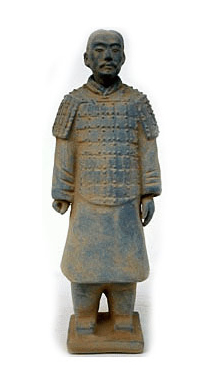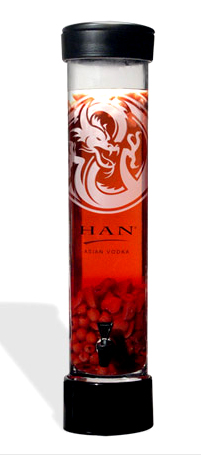Another vodka, you say? Like stilettos, vodka has been hot for longer than we can remember and shows no sign of slowing. That’s why spirits marketers are straining to think of the next big thing in what has always been called “an odorless and tasteless alcohol.”
We are vodka drinkers—we drink it neat, and we can tell you that what we drink is hardly tasteless or odorless (those words describe spring water). Sure, compared with a fine scotch, with its layers of flavors and aromas, fine vodka is subtle and elegant. Unlike a glassful of peat, smoke, charcoal and caramel, it takes a more focused palate to master the nuances of vodka. But, like the juniper of gin, when you taste it, you know it and love it.
Enter Han, the first vodka imported from Asia, created to make a difference anyone can taste—paradoxically by focusing on purity through filtration, a process that generally removes much flavor. But the filtration technology is high-tech, and the vodka is high-flavor.
Han is barley* vodka made with pure spring water, and is four-times distilled. It’s also the first “rice-infused” vodka, meaning that the barley vodka is infused with a polished rice spirit before it is filtered through the proprietary micro-quartz freeze filtration process. The micro-quartz freeze filtration technology removes impurities and preserves the rice absorption properties and natural amino acids, which the producers state cuts down on the ill effects the impurities have on body—like hangovers.
*Vodka can be distilled from a variety of grains—or even from grapes, like France’s Ciroc vodka. Grey Goose is made from a blend of grains, Ketel One from wheat, Absolut and Stolichnaya Gold from winter wheat, Belvedere from Rye. There is a common misconception that most, if not all, vodkas are made from potatoes. In fact, more than 90% of vodkas are distilled from grain—wheat, rye and corn. Potatoes and grapes are more expensive. There are several potato vodkas available in the U.S. Two of the best are Monopolowa from Poland and Teton Glacier Hand-Crafted American Potato Vodka, from Idaho.
The result is an elegant, silky-smooth taste sensation as distinctly different from other superpremium vodkas as one single malt is from another. The nose offers vanilla with hints of lemon and lime. The palate is deep and complex—a novice might think he’d been poured a glass of high-test saké, so flavorful is this vodka. More lemon and lime surround a classic vodka profile. The flavors are bright and clean—it’s not surprising that Han has won against the leading brands in blind tastings conducted by an independent company.
This is a beautiful, highly flavorful vodka that straight-vodka drinkers will find exciting. To those who think all vodkas are the same except for the packaging, Han has brought it on. We enjoyed it so much—as we would a fine wine, or the aforementioned saké—that we had to remind ourselves that we were drinking 80-proof distilled spirits before it reminded us.
Who is “Han?”
The Chinese people consider the reign of the Han Dynasty, which lasted for 400 years beginning 206 B.C., to be one of the greatest periods in the entire history of China—to  the extent that to this day, the members of the ethnic majority of Chinese people still call themselves “people of Han.” The contemporary empires of the Han Dynasty and the Roman Empire were the two superpowers of the known world; several Roman embassies to China are recounted in Chinese history. During the Han Dynasty, China officially became a Confucian state; an official and inventor named Cai Lun invented the technique for making fine paper, the revolution in communication and learning that helped civilization grow. Great military prowess ensured relatively secure caravan traffic across Central Asia—the “Silk Road” that enabled trade with the west. Unfortunately, none of the successive emperors was able to improve the harsh livelihood of peasants under the landholding families and a peasant uprising finally overthrew the dynasty; 100 years later the capital was sacked by the Huns. However, the last Han emperor was rumored to possess a secret recipe for a royal distilled spirit made from polished rice, select barleys, and pure spring water. Thus, Han Asian Vodka comes with not just great taste, but a tie to history. We know Emperor Xian Di didn’t have micro-quartz freeze filtration technology; but if his spirits tasted anything like the vodka named for him, he enjoyed some good stuff.
the extent that to this day, the members of the ethnic majority of Chinese people still call themselves “people of Han.” The contemporary empires of the Han Dynasty and the Roman Empire were the two superpowers of the known world; several Roman embassies to China are recounted in Chinese history. During the Han Dynasty, China officially became a Confucian state; an official and inventor named Cai Lun invented the technique for making fine paper, the revolution in communication and learning that helped civilization grow. Great military prowess ensured relatively secure caravan traffic across Central Asia—the “Silk Road” that enabled trade with the west. Unfortunately, none of the successive emperors was able to improve the harsh livelihood of peasants under the landholding families and a peasant uprising finally overthrew the dynasty; 100 years later the capital was sacked by the Huns. However, the last Han emperor was rumored to possess a secret recipe for a royal distilled spirit made from polished rice, select barleys, and pure spring water. Thus, Han Asian Vodka comes with not just great taste, but a tie to history. We know Emperor Xian Di didn’t have micro-quartz freeze filtration technology; but if his spirits tasted anything like the vodka named for him, he enjoyed some good stuff.
Infusions and Cocktails
The makers of Han have been quick to encourage mixologists to develop a menu of eponymous cocktails: Genghis Han (mango purée), Han-ibal Nectar (Midori  liqueur and cantaloupe balls), Han Solo (lime or olive, on the rocks), Han Dynasty (lemon wedge and mint) and Han-Sel and Gretel (cinnamon stick). They, many martini variations and other recipes, are on the brand’s website.
liqueur and cantaloupe balls), Han Solo (lime or olive, on the rocks), Han Dynasty (lemon wedge and mint) and Han-Sel and Gretel (cinnamon stick). They, many martini variations and other recipes, are on the brand’s website.
The Chai Crème Martini (photo at the top of the page) is made with another favorite product selected by the NIBBLE™, Voyant Chai Cream Liqueur. The recipe is simple and delicious:
2 oz. Han Asian Vodka
2 oz. Voyant Chai Cream Liqueur
Pour into a martini glass
Sprinkle with cinnamon
Garnish with orchid (optional)
Equally tempting is the company’s suggestion to infuse the vodka with fresh fruits. Han provides bars and clubs with large (6-quart), eye-catching infusing containers like the one at the left, but any jar will do (or, you can cut and add the ingredients to the vodka bottle—we do it all the time to make our famous prune vodka). Han suggests that you allow the fruit to steep for 24 to 36 hours; we have always infused our fruit for at least two weeks and then keep it in the jar until the alcohol is finished. (The infused fruit itself becomes overwhelmingly alcoholic and inedible. Leave it in the bottle.)
What to infuse? Name your fruit or spice. Suggestions on the Han website include:
- Apple and cinnamon
- Apricot
- Citrus
- Coconut
- Cran-Orange
|
|
- Pineapple
- Plum
- Strawberry
- Tropical Fruit
- Vanilla
|
There’s no right or wrong here: if you like passionfruit (or prunes) and want to see how it infuses, try it.
Infused, mixed or drunk neat, this is a vodka you can have fun with. One might even say, you’ll have a Han-ny of a time.
Lifestyle Direct, Inc. All rights reserved. Images are the copyright of their respective owners.